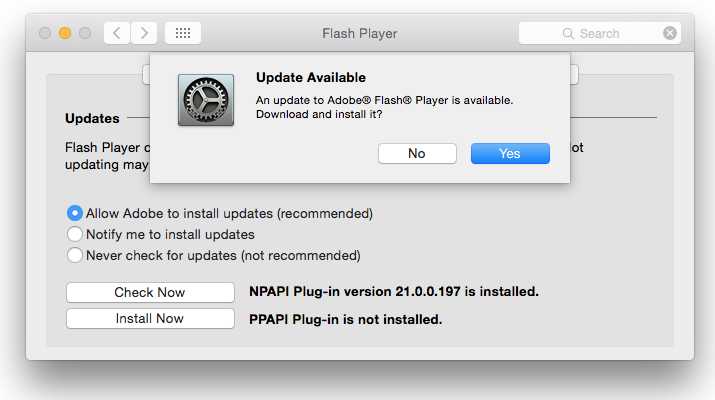Adobe Flash Drive Update For Mac
Before you start, check the version of Safari running on your Mac. To display the version number, choose Safari > About Safari.
Keep track of the latest updates of all Adobe products.

- If your Safari version is 11.0 or later, follow the steps in For Mac OS X 10.11, macOS 10.12, and later.
- If your Safari version is 10.0 or later, follow the steps in For Mac OS X 10.10.
- If your Safari version is earlier than 10.0, follow the steps mentioned in For Mac OS X 10.8 and 10.9, or For Mac OS X 10.6 and 10.7.
Click the Websites tab and scroll down to the Plug-ins section. Locate the Adobe Flash Player entry.
Select a setting to use for Flash Player when you visit other websites.
You can configure Flash for individual websites (domains). Select a website listed in this window, and choose Ask, Off, or On.
Exit Preferences after you finish configuring Flash Player.
Note:
If you are viewing Safari in full-screen mode, mouse over the top of the browser screen to see the menu.
Click the Security tab. Ensure that Enable JavaScript and Allow Plug-ins are selected. Click Plug-in Settings.
From the When visiting other websites menu, choose On, and then click Done.
Note:
If you are viewing Safari in full-screen mode, mouse over the top of the browser screen to see the menu.
Click the Security tab. Ensure that Enable JavaScript and Allow Plug-ins are selected. Click Manage Website Settings.
Select Adobe Flash Player.
From the When visiting other websites menu, choose Allow.
- Preferences'>
Note:
If you are viewing Safari in full-screen mode, mouse over the top of the browser screen to see the menu.
In the Security tab, make sure that Allow Java and Allow All Other Plug-ins are enabled.
Twitter™ and Facebook posts are not covered under the terms of Creative Commons.
Legal Notices | Online Privacy Policy
The newest versions of Adobe Flash Player on Windows and Mac OS can regularly check for updates and install them for you. Make sure that you always install the latest version of Adobe Flash Player to protect against security issues.
You can change the way Flash Player is updated by right-clicking any rich media content in your browser and choosing Global Settings from the context menu. In the pop-up window, select the Advanced tab, and select an option underUpdates.
On Windows, you can also change the setting in the Control Panel. Double-click Flash Player, click the Advanced tab, and select an option under Updates.
On Mac OS, you can also go to the System Preferences and double-click the Flash Player icon.
With the release of Flash Player 11.3, update options have changed.
Select this option to download and install updates automatically. This option provides the best protection for your system.
Urgent security updates install automatically without notification.
For scheduled updates, Adobe attempts to notify you before automatically installing them. Scheduled updates can contain enhancements andnonurgent security updates. You have the option to immediately download scheduled updates from Adobe.com and install them yourself without waiting for automatic installation.
Adobe Flash Player regularly checks for updates and notifies you when an update is available. Updates are installed only when you choose to install them.
This option is not recommended. Adobe Flash Player never checks for updates, so your system is vulnerable to security issues. It's necessary to manually check the Adobe website to find the latest version of Flash Player.
To learn about new features and the latest changes to Flash Player, click here.
To learn about the latest security fixes for Flash Player, click here.
Twitter™ and Facebook posts are not covered under the terms of Creative Commons.
Adobe Flash Update
Legal Notices | Online Privacy Policy